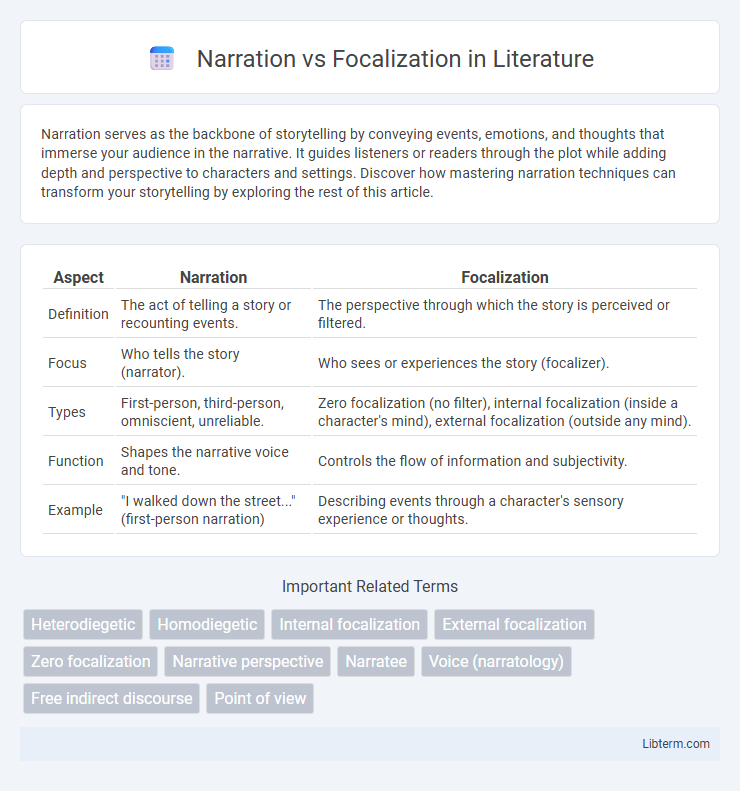Narration serves as the backbone of storytelling by conveying events, emotions, and thoughts that immerse your audience in the narrative. It guides listeners or readers through the plot while adding depth and perspective to characters and settings. Discover how mastering narration techniques can transform your storytelling by exploring the rest of this article.
Table of Comparison
| Aspect | Narration | Focalization |
|---|---|---|
| Definition | The act of telling a story or recounting events. | The perspective through which the story is perceived or filtered. |
| Focus | Who tells the story (narrator). | Who sees or experiences the story (focalizer). |
| Types | First-person, third-person, omniscient, unreliable. | Zero focalization (no filter), internal focalization (inside a character's mind), external focalization (outside any mind). |
| Function | Shapes the narrative voice and tone. | Controls the flow of information and subjectivity. |
| Example | "I walked down the street..." (first-person narration) | Describing events through a character's sensory experience or thoughts. |
Understanding Narration: A Definition
Narration refers to the act of telling a story through a specific narrative voice that guides the audience's understanding of events, characters, and settings. It involves the choice of narrator--first-person, third-person omniscient, or limited--and shapes how information is conveyed and interpreted. Understanding narration requires recognizing this framework as the structural basis for organizing and presenting the narrative's content.
What Is Focalization?
Focalization refers to the perspective through which a narrative's events and details are presented, shaping how readers perceive the story's reality. It determines whose eyes or consciousness the narrative filters through, distinguishing between internal focalization (inside a character's mind) and external focalization (an outside observer's viewpoint). Unlike narration, which is the act of telling the story, focalization focuses specifically on the narrative perspective and the limitation or scope of knowledge conveyed.
Types of Narrators in Fiction
Types of narrators in fiction include first-person, where the narrator is a character within the story using "I," third-person omniscient, with an all-knowing narrator who reveals multiple characters' thoughts, and third-person limited, which confines perspective to one character's experiences and inner thoughts. Focalization relates to the lens through which the narrative is presented, distinguishing who perceives or experiences the events, such as internal focalization (through a character's mind), external focalization (observing without access to thoughts), or zero focalization (an unrestricted narrative viewpoint). Understanding the interplay between narration and focalization clarifies how storytellers control information flow and reader engagement in literary fiction.
Focalization: Internal vs. External Perspectives
Focalization in narrative theory distinguishes between the perspective through which a story is perceived and the narrative voice. Internal focalization offers insight into a character's thoughts, feelings, and subjective experiences, allowing readers to access an intimate understanding of the protagonist or other key figures. External focalization limits the narrative to observable actions and dialogue, providing an outsider's objective viewpoint without direct access to the internal states of characters.
Key Differences Between Narration and Focalization
Narration refers to the act of telling a story from a particular perspective, defining who speaks and how events are presented, while focalization concerns the lens through which the story is perceived, determining which character's viewpoint shapes the narrative experience. The key difference lies in narration being about the narrative voice and its reliability, whereas focalization focuses on the subjective experience and access to characters' thoughts and perceptions. Understanding these distinctions is essential for analyzing narrative techniques, as narration controls storytelling structure and focalization influences emotional engagement and interpretation.
The Role of Narration in Storytelling
Narration serves as the guiding voice that controls the delivery and perspective of a story, shaping how events and characters are perceived by the audience. It establishes the temporal and spatial context, influencing narrative reliability and emotional engagement. By selecting focalization, narration filters the narrative through a specific consciousness, enhancing thematic depth and character insight.
How Focalization Shapes Reader Experience
Focalization directs the reader's perspective by controlling the flow of information and aligning the narrative with a specific character's point of view, enriching emotional engagement and subjective interpretation. By limiting or expanding access to a character's thoughts and perceptions, focalization creates varying degrees of intimacy and uncertainty that influence suspense and empathy. This narrative technique shapes how readers perceive events and characters, ultimately guiding their emotional and cognitive responses to the story.
Examples of Narration and Focalization in Literature
Narration in literature is exemplified by the omniscient narrator in "Pride and Prejudice" by Jane Austen, who provides an all-knowing perspective on characters and events, while focalization focuses on the viewpoint of a specific character, as seen in "The Catcher in the Rye" by J.D. Salinger, where the story is filtered through Holden Caulfield's personal experiences. In "Mrs. Dalloway" by Virginia Woolf, stream of consciousness techniques highlight internal focalization by diving into the thoughts of Clarissa Dalloway, contrasting with the external narration used in traditional storytelling. These examples illustrate how narration offers a broad narrative scope whereas focalization controls the narrative perspective and emotional depth through individual consciousness.
Common Mistakes: Mixing Narration and Focalization
Mixing narration and focalization often leads to confusion between the narrator's voice and the character's perspective, which can disrupt the clarity of the narrative. A common mistake is shifting focalization without clear signals, causing readers to misinterpret whose thoughts or feelings are being conveyed. Maintaining consistent focalization while clearly distinguishing it from the omniscient narration avoids ambiguity and enhances narrative coherence.
Choosing the Right Technique: Narration or Focalization?
Choosing between narration and focalization depends on the desired depth of perspective and narrative control; narration offers an omniscient overview, providing broad context and comprehensive insight into events and characters. Focalization restricts the viewpoint to a specific character's perception, intensifying emotional engagement and subjective experience, especially in first-person or limited third-person narratives. Writers prioritize narration for clarity and exposition, while focalization enhances intimacy and psychological complexity, shaping the reader's alignment and interpretation of the story.
Narration Infographic

 libterm.com
libterm.com